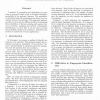Free Online Productivity Tools
i2Speak
i2Symbol
i2OCR
iTex2Img
iWeb2Print
iWeb2Shot
i2Type
iPdf2Split
iPdf2Merge
i2Bopomofo
i2Arabic
i2Style
i2Image
i2PDF
iLatex2Rtf
Sci2ools
MVA
2002
2002
Fingerprint Identification Using the Accidental Coincidence Probability
A method of comparing and identifying two patterns is proposed based on the accidental coincidence probability of the patterns' features. The probability is calculated under the assumption that there is no correlation between the patterns. This approach makes it possible to overcome the difficult problem of estimating the probabilities of features missing and spurious features occurring. Applying this method to fingerprint identification, we show that it can be used to control the probability of imposter acceptance. Therefore, this method is suitable for security applications.
Accidental Coincidence Probability | Computer Vision | Difficult Problem | Imposter Acceptance | MVA 2002 |
| Added | 22 Dec 2010 |
| Updated | 22 Dec 2010 |
| Type | Journal |
| Year | 2002 |
| Where | MVA |
| Authors | Akira Monden, Seiji Yoshimoto |
Comments (0)

